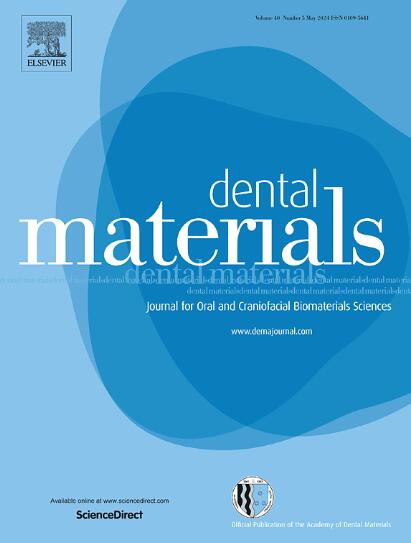铣削工艺对不同CAD-CAM材料疲劳行为的影响。
IF 4.6
1区 医学
Q1 DENTISTRY, ORAL SURGERY & MEDICINE
引用次数: 0
摘要
目的:评估玻璃陶瓷和树脂复合材料在四轴铣床上以两种不同的方案铣削的疲劳行为。方法:二硅酸锂和树脂复合冠在四轴铣床上采用精细或超精细模式铣削(n= 15)。扫描了全冠磨牙纤维增强树脂环氧树脂模具作为基板。采用不同的表面处理方法,修复体采用双树脂胶粘剂粘接。进行了循环疲劳试验(20 Hz,初始载荷400 N,步长50 N至1500 N,然后增加到100 N,每步循环10,000次),以评估疲劳行为直到第一个裂纹。所有试件均进行断裂载荷试验,直至发生突变断裂。还进行了有限元分析、形貌分析和断口分析。但磨损进行了分析。Kaplan-Meier检验和双向方差分析分别分析了疲劳行为和断裂载荷。结果:两种材料的铣削方式在疲劳行为上没有显著差异。树脂复合材料在开裂前的存活率高于二硅酸锂。各组间骨折负荷无明显差异。与精细铣削模式相比,超精细铣削模式促进更高的磨损。在两种材料中都观察到明显的接触损伤。意义:与二硅酸锂相比,无论铣削方式如何,树脂复合冠在裂纹检测前都表现出优越的疲劳性能。在铣削方式和修复材料之间,突变断裂载荷没有显著差异。本文章由计算机程序翻译,如有差异,请以英文原文为准。
The influence of milling protocols on the fatigue behavior of different CAD-CAM materials
Objectives
To assess the fatigue behavior of a glass-ceramic and a resin composite milled with two different protocols in a 4-axis milling machine.
Methods
Lithium disilicate and resin composite crowns were milled using fine or extra fine mode in a 4-axis machine (n= 15). A full crown molar fiber-reinforced resin epoxy die was scanned and used as substrate. Respective surface treatments were applied, and the restorations were bonded with dual resin cement. Cyclic fatigue test was carried out (20 Hz, initial load 400 N, step size 50 N up to 1500 N, then increased to 100 N with 10,000 cycles per step) to assess the fatigue behavior up to the first crack. All specimens were submitted to a fracture load test until catastrophic fracture. Finite element analysis, topography, and fractography were also conducted. Bur wear was analyzed. Kaplan-Meier and two-way ANOVA tests were carried out to analyze fatigue behavior and fracture load, respectively.
Results
No significant difference in fatigue behavior was observed between the milling modes for both materials. Resin composite presented a higher survival rate until crack than lithium disilicate. No difference was found in fracture load among the groups. Extra fine milling mode promotes higher bur wear compared to the fine mode. Noticeable contact damage was observed in both materials.
Significance
Resin composite crowns exhibit superior fatigue behavior until crack detection compared to lithium disilicate, regardless of the milling mode. No significant difference in catastrophic fracture load was observed between the milling modes or the restorative materials.
求助全文
通过发布文献求助,成功后即可免费获取论文全文。
去求助
来源期刊

Dental Materials
工程技术-材料科学:生物材料
CiteScore
9.80
自引率
10.00%
发文量
290
审稿时长
67 days
期刊介绍:
Dental Materials publishes original research, review articles, and short communications.
Academy of Dental Materials members click here to register for free access to Dental Materials online.
The principal aim of Dental Materials is to promote rapid communication of scientific information between academia, industry, and the dental practitioner. Original Manuscripts on clinical and laboratory research of basic and applied character which focus on the properties or performance of dental materials or the reaction of host tissues to materials are given priority publication. Other acceptable topics include application technology in clinical dentistry and dental laboratory technology.
Comprehensive reviews and editorial commentaries on pertinent subjects will be considered.
 求助内容:
求助内容: 应助结果提醒方式:
应助结果提醒方式:


